New Report from the NextGen Consortium Shares Path Forward for Paper Cup Recycling in the U.S.
November 01, 2023
Insights include solutions for paper mills, materials recovery facilities, brands and communities to increase recovery of paper cups and reduce waste to landfill
Nov. 1, 2023 — Today, the NextGen Consortium, a leading industry collaboration managed by Closed Loop Partners, with partner brands including Starbucks, McDonald’s, The Coca-Cola Company, PepsiCo, JDE Peet’s, The Wendy’s Company and Yum! Brands, released a report with new findings to accelerate paper cup recycling in the U.S. The report, Closing the Loop on Cups: Collective Action to Advance the Recovery of Paper Cups in the U.S., assesses the role of each stakeholder across the paper cup recovery value chain––including paper mills, materials recovery facilities (MRFs), brands, consumers and local communities––and provides recommended actions to increase paper cup recovery opportunities and advance a more circular system.
Every day, millions of people around the world drink from paper cups. They’re safe, functional and convenient–– so much so that globally, more than 250 billion cups are produced each year. But convenience comes with environmental consequences: the majority of cups end up in landfill today. The NextGen Consortium has taken a three-pronged approach to address cup waste holistically: 1) Advancing reusable cup systems that keep materials in circulation for multiple uses, 2) Exploring material science innovation that enhances the sustainability and recoverability of cup materials, and 3) Strengthening materials recovery and recycling infrastructure that recaptures cups after use.
In this report, the NextGen Consortium focuses on the need to strengthen existing materials recovery and recycling infrastructure systems to recapture more paper cups. Recovering and recycling paper cups ensures the value embodied in paper cups—primarily comprised of fiber and a plastic liner—is recovered, rather than wasted in landfill. These cups contain high-quality fiber that is valuable to paper mills as other paper sources like newsprint and office paper decline. While the challenges for paper cup recovery and recycling are significant, collaboration among various stakeholders involved in paper cup recovery can help address its scale and complexity. The report highlights key challenges and opportunities, including:
- Today, only about 11 percent of communities accept cups in their recycling operations. This poses a significant barrier to cup recycling, as residents have few options to properly recycle their used cups.
- While only a handful of cities in the U.S. are officially accepting cups in their recycling programs, the Foodservice Packaging Institute (FPI) identified more than 30 paper mills that accept paper cups in mixed paper bales representing 75 percent of U.S. mixed paper demand, and an additional five mills accepting cups in carton bales. These mills are taking recovered paper materials, including cups, and reprocessing them into new products.
- In 2023, the NextGen Consortium, in collaboration with FPI and Moore & Associates, identified more than 15 additional mills across North America that are interested in testing cup acceptance or that can process cups today. This new interest is a tremendous endorsement for the work that is taking place and can catalyze cup acceptance at MRFs and in new communities in the months and years ahead.
- Each stakeholder in the value chain has an important role to play in improving paper cup recycling. The report outlines key calls to action, including calling on:
- Mills to conduct recycling tests on paper cups to determine if the fiber can be captured without any negative operational impacts at their facilities;
- MRFs to conduct material flow studies to determine where best to site interventions for cup sortation and to collaborate with mills and communities to expand acceptable recycling lists as more mills accept cups;
- Communities to engage with MRFs and mills to evaluate feasibility of adding cups to accepted recyclables list;
- Consumers to bring their own reusable cups when they can and to check local recyclability options and guidance when using disposable cups;
- Brands to source recycled paper content when procuring their cups and other packaging, among other activities.
“The waste generated from to-go paper cups has become a highly visible representation of our disposable, take-make-waste culture. However, these cups also are a valuable resource with growing opportunities for recovery,” says Kate Daly, Managing Director and Head of the Center for the Circular Economy at Closed Loop Partners. “We know that collaboration across stakeholders––from mills and MRFs to brands and cities––is going to be critical to solving this challenge and ensuring paper cups don’t end up in landfill or polluting our environment. The NextGen Consortium plays a key role in advancing the innovation, testing and partnerships needed to make this possible.”
Since its founding in 2018, the NextGen Consortium has taken a holistic and collaborative approach to addressing the challenge of single-use cup waste, advancing reuse models, exploring material science innovations and strengthening materials recovery and recycling infrastructure that recaptures cups after use. While material reduction and reuse are key pathways to reduce reliance on virgin resource extraction, end-of-life recovery pathways are equally critical to ensure that the value embodied in all types of cups, including single-use paper cups, is recovered, rather than wasted in landfill.
As the NextGen Consortium works toward its goal of eliminating foodservice packaging waste, it will continue to work to improve and align recovery and recycling infrastructure across the entire value chain, from collection and sortation to processing and strengthening end markets. Collaborative action, data-driven decision-making and iterative testing continue to be critical to closing the loop on a greater diversity and volume of valuable resources and avoiding unintended consequences. The learnings from this report aim to guide the industry towards a future in which reusing valuable materials in products becomes the commonsense norm, shaping a more circular economy.
About the NextGen Consortium
The NextGen Consortium is a multi-year consortium that addresses single-use foodservice packaging waste globally by advancing the design, commercialization and recovery of foodservice packaging alternatives. The NextGen Consortium is managed by Closed Loop Partners’ Center for the Circular Economy. Starbucks and McDonald’s are the founding partners of the Consortium, with The Coca-Cola Company and PepsiCo as sector lead partners. JDE Peet’s, The Wendy’s Company and Yum! Brands are supporting partners. The World Wildlife Fund (WWF) is the environmental advisory partner. Learn more at www.nextgenconsortium.com.
About the Center for the Circular Economy at Closed Loop Partners
Closed Loop Partners is at the forefront of building the circular economy. The company is comprised of three key business segments: Closed Loop Capital Management, the Center for the Circular Economy and Circular Services. In 2018, Closed Loop Partners launched its innovation center, the Center for the Circular Economy, which unites competitors to tackle complex material challenges and to implement systemic change that advances the circular economy. Closed Loop Partners brings together designers, manufacturers, recovery systems operators, trade organizations, municipalities, policymakers and NGOs to create, invest in and support scalable innovations that target big system problems. Learn more about the Center’s work here.
Reuse
When Reusable Cups Reach End-of-Life: 5 Tips to Ensure They Don’t Go to Waste
October 18, 2023
We know reuse plays a critical part in reducing foodservice packaging waste. And we’ve seen progress and innovation across all types of packaging and foodservice venues, whether cup share programs, reuse at concerts and events, or even for food delivery services. However, for reuse models to be successful and impactful, they need to check a lot of boxes––they have to fit the lifestyle of customers and align with the reality of retail operations to ensure reusable packaging is sufficiently reused. They also have to be recyclable so that they don’t become waste when they end up somewhere other than the return bin at any point in their lifecycle. Whether a reuse program has a 95 percent (terrific!), 75 percent (needs improvement) or 25 percent (look out!) return rate, designing for recyclability is key, especially as more reusable packaging enters the ecosystem. Appropriate end-of-life management is necessary to maximize the intended environmental benefit that reusable products offer.
Since 2018, the NextGen Consortium has been leading efforts to identify the role reuse can play in addressing foodservice packaging waste, alongside material innovation and recovery [see: Bringing Reusable Packaging Systems to Life: Lessons Learned from Scaling Reusable Cups]. In addition to examining the realities of consumer behavior and retail operations when deploying reuse systems, one critical question we recently investigated is: what happens when a reusable cup ends up in the recycling system?
Reusable foodservice packaging is often designed for durability––both in how long it can be reused and how many times it can be washed––but not always for recyclability. As a result, when reusable cups are decommissioned, or end up anywhere but the reuse bin, they inevitably end up in our waste streams. From NextGen’s consumer research, we know that unless disposal options are convenient, these cups will likely end up as waste. Designing reusable packaging for both consistent reuse and eventual recyclability will help increase recovery opportunities and reduce waste to landfill and the environment.
How do we ensure reusable cups do not become waste when they can no longer be reused or end up in a recycling bin rather than a reuse bin?
Testing is key. There are excellent design guidelines, such as APR’s design for recyclability guidelines, to help suppliers ensure their packaging meets the stated needs of the recycling system today. But reusable cups also need to be tested within the recycling process to see if they can be successfully recovered. There are three critical stages of the recycling process:
- Collection: how recyclable materials are collected in residential or commercial waste streams
- Sortation: how a package will flow at a material recycling facility (MRF)
- Reprocessing: how a package aligns with similar materials to be processed and remanufactured into new materials
In early 2023, the NextGen Consortium collaborated with Van Dyk Technology Center to test how a dozen different reusable polypropylene (PP) cups would sort within a MRF and see if they would end up in the correct material bale, in this case PP.
The test mimicked the flow of a typical MRF, followed APR’s sorting guidance and tested how size, compression, 2D and 3D sortation, and near infrared (NIR) sortation impact how well a cup can be sorted. The results were mixed and provide critical design insights for the companies who are manufacturing and deploying reusable cup formats.
The Results: the good, the bad and the unrecyclable.
When designed with recycling in mind, a reusable PP cup should successfully sort into the correct bale at a MRF. In our tests, the top four best performing cup models were sorted correctly more than 90 percent of the time. The test ran 50 samples of each cup through four separate runs so that each cup model ran through the facility 200 times. The results are no coincidence: successful sortability was driven by specific factors, including color, shape, opacity, thickness and material composition. The highest performing cups were typically opaque, thin and rigid but had some flexibility or bounce, and were all read clearly by the optical sensors of the sortation equipment. Cups that performed poorly, sorting less than 50 percent of the time (or sometimes not at all), often were more translucent than their successful counterparts. Overall, while only four of the cups achieved successful sortation (and a fifth cup was borderline), simple design corrections can improve the fate of the others.
Design Tips: Making recyclability a priority for reusable PP cups.
The Van Dyk sortation test gave a window into what happens to various types of reusable PP cups traveling through a MRF. However, this only assessed one step in the recycling process––sortation––and does not confirm compatibility with reclamation systems nor prove that the cup can be recycled effectively into a new package. Additional testing is needed to confirm assumptions that reusable PP cups are truly circular. For now, reusable foodservice packaging companies and suppliers can design with sortation in mind and improve end-of-life outcomes by considering the following:
- Follow the design guidelines created by APR and other groups: There are many resources available online to help packaging designers/suppliers ensure greater compatibility with the recycling system. For plastic packaging, the APR Design® Guide is a great place to start.
- Avoid all black plastics: While there have been technological advancements to help sort black plastics, most MRFs do not possess that technology. Both opaque and translucent black packaging is problematic and reusable cup manufacturers should design cups with today’s system in mind. If black is absolutely required, use an NIR sortable black colorant. Colorants that have passed APR testing can be found on APR’s website here.
- Not all polypropylene is equal: PP is a wide class of material. PP sorters in the recycling process are designed to detect and separate PP that is common to single-use plastic such as tubs and lids; however, other PP grades may not be as easily identified.It is critical to engage with your cup suppliers and test if needed to confirm compatibility.
- Mono materials (cups made of just one material) are best: A reusable cup that is multi-material (i.e., part plastic, part fiber, part silicone, etc.) is simply not compatible with today’s recycling system. Cups designed to be in a high-volume sharing system should be made of a singular material and avoid too many add-ons. Cups with ridges (i.e., a built-in sleeve) may also impede sortation; however, it does not appear that those design features are overly detrimental.
- Think twice before adding tech: Tracking systems are typically needed to assess the impact of a reuse system and enable traceability, but features such as Radio Frequency Identification (RFID) tags need to be evaluated further for their impact on the recycling system. While an RFID tag is unlikely to hinder a package’s sortability, it might impact whether a material can be reclaimed or recycled. APR’s guidance lists RFID tags as “detrimental,” and the NextGen team is investigating the impact this technology has on the system.
When in doubt, TEST.
Despite widely available design guidance, reusable packaging that is not compatible with today’s recycling system continues to be manufactured. The conversation needs to be more nuanced and shift from only discussing designing for durability and the number of washes a package can withstand, to the realities of how the packaging will actually be used and travel through a system. Most reusable wares in an open system would be lucky to hit 40 reuses (which would assume a >95% return rate)! Sortation and recovery testing can help provide reusable foodservice packaging companies with additional peace of mind and ensure that their packaging has a better chance of staying out of landfill.
The NextGen team looks forward to continuing this journey to study and test optimal conditions for reusable packaging to succeed and achieve a positive environmental impact within a circular economy.
How a South Carolina Paper Mill Started Recycling Your Paper Coffee Cups
September 26, 2023
A spotlight on Sonoco and its recycling tests with the NextGen Consortium
In July 2022, Sonoco announced it would accept paper cups in bales of mixed paper at its paper mill in Hartsville, South Carolina. The NextGen Consortium supported cup trials with Sonoco. Below, we discuss with Scott Byrne, Director, Global Sustainability Services at Sonoco how the organization made this decision and what considerations companies might want to take when exploring the recyclability of different types of packaging.
This work represents part of a forthcoming report on paper cup recovery in the United States intended for release in late fall.

Scott Byrne, Director, Global Sustainability Services at Sonoco
1. Who is Sonoco and what are you focused on?
Sonoco is a South Carolina-based global packaging company with more than 20 mills worldwide. Among our packaging products, we manufacture rigid paper cans, steel cans, thermoformed plastics and other packaging formats. Sonoco is uniquely positioned as a leading recycler, paper mill operator and paper packaging converter, in addition to other formats, to help push the industry to look towards future innovations and grow end-of-life solutions across the entire paper value chain.
2. How do you typically approach recycling of new products at your mills?
After validating that our mills could recycle rigid paper cans in residential mixed paper, we decided to further demonstrate the ability to recycle other similar polycoated fiber-based containers through the post-consumer mixed paper stream.
3. Where do you currently accept paper cups?
Hartsville, South Carolina. and we are exploring other Sonoco mills as well that use residential mixed paper.
4. What are some of the steps you took to determine that accepting cups wouldn’t create new challenges for your mill?
With support from the NextGen Consortium, we conducted two main activities to assess how cups might behave. First, we conducted lab-based testing of both single- and double-sided poly-coated fiber cups. Second, and after we were confident that the cups would not pose any issues to our equipment, we ran a large-scale trial whereby we dosed in nearly 20 tons of cupstock and cups into our pulper alongside other mixed paper, increasing the volume relative to other materials to test the system and upper bounds of materials we’d anticipate receiving if we accepted cups. Based on those results we felt confident that cups could be included in our accepted materials list and we were thrilled to have the mill listed alongside others on Foodservice Packaging Institute’s end market map of mills that accept cups.
5. What about your other paper mills?
Before we broadly accept cups at more of our mills, we’d want to distill our findings from the Hartsville location and consider any additional steps those mills would need to take to feel confident in accepting cups. This might include additional lab-and mill-based trials.
6. Any advice you’d give to other mills considering including cups?
Every mill is slightly different, from their equipment to operating conditions to inbound material mix. Testing to those conditions is a key proof point in determining what might work best in that location.
7. What’s next for Sonoco in its efforts to improve polycoated paper recycling?
Sonoco is a founding member of the Polycoated Paper Alliance that kicked-off in March 2023, which aims to increase widespread end-market acceptance of polycoated paper packaging products. We are collaborating with like-minded member brands and industry leaders on developing improved and harmonized data, updated design guidelines, expanded end market acceptance and upgraded mill specifications, among other initiatives.

How AI Could Change the Way We Think About Recycling
September 11, 2023
Closed Loop Partners’ Center for the Circular Economy and the NextGen Consortium launch a new study with AI technology company Greyparrot to analyze the composition of polypropylene in recycling streams
Behind the walls of recycling facilities across the U.S., a sea of materials moves through hands and machines working hard to get them to the end of the line––and the beginning of their next life. A critical balance of manual labor and automation enables the sorting and recovery of these materials in a closed loop system. Yet despite a multi-step sortation process, it is difficult to track what flows through the system at all times. It’s a challenge that results in many recycled materials losing potential value, in addition to millions of dollars worth of valuable material being sent to landfill unintentionally.
Among the diverse materials flowing through the recycling system are the yogurt containers, and iced coffee and fountain beverage cups many of us use on a regular basis. These are just a few examples of products made of one of the most commonly used resins in foodservice packaging today: polypropylene (PP). PP is a valuable material that should be kept in circulation to reduce waste and meet corporate commitments to use more recycled content in foodservice packaging. With that said, very little mechanically recycled food-grade PP actually cycles back into food-grade applications. Most end up in nonfood-grade applications that limit their value and the number of times they can be reused. To create a more circular path for food-grade PP, we must first answer the question: what is in the PP stream today, and how much of it is food-grade or clear food-grade PP?
The NextGen Consortium is a multi-year industry collaboration addressing single-use foodservice packaging waste by advancing solutions across material innovation, reuse and recovery infrastructure––and it’s working to answer that question. In the fall of 2022, the Consortium partnered with Resource Recycling Systems to examine PP bales in two materials recovery facilities (MRFs) to learn what was inside. While only a snapshot in time, the results were enlightening.
On average, nearly half of the PP bales (48%) were presumed food-grade, and more than a quarter of the bales were clear food-grade (26%). Clear beverage cups represented 14% of the bale on average. The high percentage of food-grade PP suggested that there is untapped value in the PP stream. A better system is required to ensure food-grade and/or clear food-grade PP is properly sorted into a separate bale at some point in the value chain if we are to retain its highest potential value.
This year, the NextGen Consortium is diving even deeper, launching a first-of-its-kind study leveraging artificial intelligence (AI) to analyze the composition of the PP material stream well before it ends up in a bale. Together with its managing partner––Closed Loop Partners’ Center for the Circular Economy––the NextGen Consortium is working with Greyparrot, a leading AI waste analytics platform for the circular economy. The collaboration aims to track and categorize objects in the PP stream, and determine the volume of valuable food-grade material passing through the system. AI is on the rise as one potential means of increasing visibility into the recycling process. Today, more technologies are needed to handle an increasingly mixed stream of collected materials, including plastics, electronics, textiles and food scraps––and to enable the recovery of clean, high-quality materials.
“Ensuring that recovery infrastructure can keep pace with a rapidly growing and diverse material stream is critical to advancing the circular economy, alongside solutions such as material innovation, reduction and reuse,” said Kate Daly, Managing Director and Head of the Center for the Circular Economy at Closed Loop Partners. “An important part of our work in the NextGen Consortium is identifying opportunities for data collection and analysis that can advance the circularity of foodservice packaging, and drive greater value for stakeholders across the system, including brands, innovators, infrastructure operators and consumers.”
As part of this project, the Greyparrot Analyser units will be installed above the PP recovery conveyor belts at four leading U.S. MRFs: Balcones Recycling, TX; Cougles Recycling, PA; Rumpke Recycling, OH; and Eureka Recycling, MN. Greyparrot’s AI-powered computer vision system uses cameras to capture images of objects in the PP stream, aiming to quantify and qualify the materials flowing through the MRFs. Their AI model will look to categorize each object based on material, format, financial value and brand, as well as distinguish food- and nonfood-grade material, using those images. Their units will then send that data to an analytics dashboard in real-time. Through machine learning, the flexible vision systems can help improve their package recognition and classification over time.
“We use artificial intelligence to gain continuous and reliable visibility into recycling streams,” said Ambarish Mitra, Co-founder and CPO of Greyparrot. “This helps us improve recycling operations by placing waste intelligence into the hands of the people who are recovering, redesigning and remanufacturing the objects we throw away. We are thrilled to work with our U.S. partners towards our vision of a future where every piece of waste is valued as a resource.”
The collaborative project––a first of its kind in North America––will run for more than six months. During that period, it will gather data on the composition of PP bales over time, while accounting for seasonality. That insight can help determine the potential untapped value in these streams, and identify other materials that might be coming through unintentionally. This data can also help shed light on the presumed volume of food-grade material being captured in the system, along with opportunities for recovery and separation into distinct value chains. More broadly, this can advance a circular economy for valuable materials, improve material quality delivered to recycling facilities, and enhance the value of recyclable commodities shipped to U.S. end markets.
“A lot is unknown about the curbside polypropylene stream today. Filling these knowledge gaps can increase the pace of development for material recovery. Understanding the composition of the stream in a large-scale study highlights potential, reduces risk for pioneers and accelerates better design implementation. This study will be the catalyst to developing much larger-scale recycling of polypropylene,” said Curt Cozart, President of Common Sense Solutions and Technical Advisor to the project.
PP cup recovery––alongside material innovation, reuse and fiber cup recovery––is a critical focus for the NextGen Consortium. According to The Recycling Partnership, more than 2 billion pounds of PP are generated every year by single-family households in the U.S. If just 30% of this material were recovered, it would reduce greenhouse gas emissions by over 300,000 metric tons, providing over 600 million pounds of valuable raw material to companies with recycled content commitments for their foodservice packaging, both voluntary and mandated.
The NextGen Consortium has been actively involved in PP recovery since 2021, when it joined The Recycling Partnership’s Polypropylene Recycling Coalition as a Steering Committee member. Through this initiative, the group helps to fund equipment grants for MRFs so that they can effectively capture PP packaging, and improve community recycling access rates. In addition to improving recycling access, the NextGen Consortium is committed to driving recycling rates by supporting the recovery of post-consumer recycled content (PCR) that can be re-incorporated into packaging.
This collaboration with Greyparrot and MRFs across the U.S. is one critical step toward achieving the NextGen Consortium’s goals. As more data about the PP material stream is captured over the next six months, the Consortium will analyze the new data, identifying opportunities to improve PP sortation and recovery into higher value, new food-grade applications and areas where more research is needed. The NextGen Consortium continues to invite additional MRFs to participate in the project, to gain a better understanding into what is flowing through their material streams and identify ways to drive more value to the system.
About the NextGen Consortium
The NextGen Consortium is a multi-year consortium that addresses single-use food packaging waste globally by advancing the design, commercialization, and recovery of food packaging alternatives. The NextGen Consortium is managed by Closed Loop Partners’ Center for the Circular Economy. Starbucks and McDonald’s are the founding partners of the Consortium, with The Coca-Cola Company and PepsiCo as sector lead partners. JDE Peet’s, Wendy’s and Yum! Brands are supporting partners. The World Wildlife Fund (WWF) is the environmental advisory partner. Learn more at www.nextgenconsortium.com.
About the Center for the Circular Economy at Closed Loop Partners
Closed Loop Partners is at the forefront of building the circular economy. The company is comprised of three key business segments: Closed Loop Capital Management, the Center for the Circular Economy and Circular Services. In 2018, Closed Loop Partners launched its innovation center, the Center for the Circular Economy, which unites competitors to tackle complex material challenges and to implement systemic change that advances the circular economy. Closed Loop Partners brings together designers, manufacturers, recovery systems operators, trade organizations, municipalities, policymakers and NGOs to create, invest in, and support scalable innovations that target big system problems. Learn more about the Center’s work here.
Reuse
Making Reuse an Everyday Reality: 3 Things We Must Consider Before Scale
September 06, 2023
Reuse is now at a critical stage of development. A plethora of innovation has expanded the realm of possibilities, but what will it take to get to the point of industry-scale disruption?
Earlier this year, seven winners of the highly anticipated 2023 Reusies were announced on stage at GreenBiz’s Circularity23 Conference in Seattle. The winners encompassed corporate and community initiatives, and B2B and B2C reuse innovations across food & beverage, consumer packaged goods and fashion & apparel. Together, they provided a window into the best and brightest developments in the reuse space. Indeed, hundreds of start-ups and large corporates are working on making reuse an everyday reality for consumers, with applications as far-ranging as closed system solutions for corporate campuses and events, to software companies supporting reuse-as-a-service, and refill applications in retail or in commercial, industrial and event spaces. The potential for reuse to reduce waste has catalyzed much innovation and brought conversations to a fever pitch.
Reuse is now at a critical stage of development. A plethora of innovation has expanded the realm of possibilities, but what will it take to get to the point of industry-scale disruption? Making reuse a far-reaching and everyday reality––where reusable items are consistently and efficiently reused to make a significant difference and reduce environmental impact––requires continued testing, collaboration across the value chain, investment and supportive policy.
At Closed Loop Partners, reuse systems are an integral part of our vision of a transition away from the take-make-waste economy and toward a circular economy. When products that have historically been single-use are able to be used two, five, ten or one hundred times, and the proper recovery infrastructure is in place for their eventual end-of-life, that can make a meaningful difference on reducing valuable materials sent to landfill––and on the embodied carbon, water and materials required to produce the item in the first place.
But to get to this next horizon, a number of factors must be considered to ensure that reuse does not result in unintended consequences and instead serves a truly circular economy:
1. Closed or semi-closed reuse systems are a key starting point, especially at early stages of adoption. On-premise reuse unlocks higher return rates which can make reuse systems profitable––or at least breakeven. In open systems, as consumers use and dispose products away from point of adoption, more complex collection networks and communication strategies are needed to drive returns. For this reason, closed systems can operate with lower upfront capital expenditures and lower recurring operating expenditures until the time at which consumer behavior has shifted to be more amenable to open systems (see #3!).
2. Reuse is a hardware-first business, and requires capital and collaborations to build localized infrastructure––including collection, sorting and washing. There continues to be a shortage of washing infrastructure needed for reuse solutions, and traditional waste management players are not currently set up for the type of collection and sorting needed for reusable products that are intended to stay in circulation for more than one use. Many software-only solutions still require partnerships with washers and logistics providers. There is an opportunity for founders, corporates and municipal governments to build out these partnerships to enable reuse and share in the funding that will be required to build this new infrastructure.
3. Broad consumer adoption starts with meeting customers where they are today. There are still many customers that have yet to be onboarded into the reuse culture. As we’ve seen in our work through the Beyond the Bag Consortium and the NextGen Consortium, we need to design solutions with current behaviors in mind and support customers as they build new habits. Advancing reuse won’t happen overnight; cross-industry and cross-company collaboration, a range of solutions, clear messaging and consistent regulatory frameworks are required to effectively support consumers in adopting reuse within their communities, as the industry addresses complex waste challenges. Importantly, in-market testing plays a key role in unlocking what works effectively in the market and meets customer needs. Today’s market is complex, with diverse customer demographics and shopping habits, different operations across retailers, a range of reuse packaging materials and more that need to be considered.
We see experimentation as a critical precedent to scale. Reuse is no simple feat, and testing market fit and operation alignment is an important step to expand reuse responsibly and mitigate unintended consequences that can happen without a measured examination of new systems. But isolated, small-scale experiments will not get us there. Closed Loop Partners runs multi-brand reuse tests through its Center for the Circular Economy to identify tactics that are proven and ready to scale, as well as models that require further tweaking and iteration to deliver the expected environmental and financial outcomes. While we work to scale proven solutions, we continue to de-risk systems that need refinement. Our in-field deployments intentionally mimic large-scale, cross-brand implementation, but in a controlled manner. The insights and data gleaned from these tests are key stepping stones to new rounds of implementation and scale. Most recently, the Beyond the Bag Consortium’s largest multi-brand reusable bag pilots tested a range of reuse solutions to understand what it will take to effectively drive reduction of single-use plastic bags. Next year, the NextGen Consortium will go back into market to test the viability of reusable cup systems across multiple brands. These tests unlock important insights on what it will take to build a culture of reuse and will serve as the foundation for identifying scalable initiatives.
With all these developments, we believe we’ll get there. There are tremendous tailwinds supporting the development of reuse and a multitude of communities, innovators and corporations committed to seeing the shift through. To do so, the next five years are critical to pivot from bespoke solutions to shared frameworks, from ad hoc consumer engagement to a consistent drumbeat, and from in market tests to truly scaled solutions. We are excited to be working to advance the transition from innovation to scaled solutions that can replace single-use. Join us!
This article represents perspectives from across Closed Loop Partners, including the Center for the Circular Economy and Closed Loop Capital Management. Special thanks to Kate Daly, Carol Lobel, Danielle Joseph, Aly Bryan and Anne-Marie Kaluz for sharing their thoughts for this piece.
Molecular Recycling
What Is Chemical Recycling, Why Does It Have So Many Different Names, and Why Does It Matter?
August 15, 2023
Closed Loop Partners spent 18 months investigating the environmental impacts and financial viability of several types of molecular recycling technologies (sometimes also called advanced recycling or chemical recycling) to understand how and if these diverse technologies can fit into a circular future for plastics. Here’s what we found.
- Molecular recycling is a diverse sector that can be categorized into three distinct technology categories: purification, depolymerization and conversion.
Figure 1: Molecular Recycling Technology Categories and Their Outputs

Molecular recycling is a broad umbrella term – also referred to as chemical recycling or advanced recycling – that encompasses dozens of technologies that use solvents, heat, enzymes, and even sound waves to purify or break down a wide range of plastic feedstocks to create polymers, monomers, oligomers or hydrocarbon products so that they can re-enter manufacturing supply chains, instead of going to landfill.
In other words, molecular recycling technologies can break down plastic waste into its constituent building blocks, which can then be used to create new plastic products. These technologies are only circular when their supply chains produce a final product. Converting plastics to fuel is not recycling or circular. Molecular recycling is a group of technologies that can complement mechanical recycling and help widen the aperture of plastic waste that we can recycle today.
- Molecular recycling is only one part of a suite of solutions to address plastic waste; both upstream and downstream solutions are needed, including design and reuse, as well as mechanical and molecular recycling, and policy.
Figure 2. The suite of solutions needed to reduce plastic waste
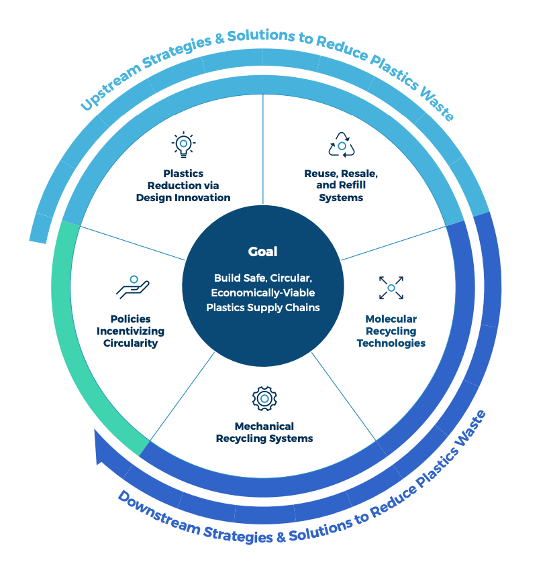
Molecular recycling is part of a suite of solutions needed for a circular plastics economy. It is not a silver bullet but plays an important role in creating a waste-free future for our hardest-to-recycle plastics which include the 41 million metric tons of textiles and approximately 2,000 wind turbine blades expected to go to landfill in the U.S. every year.
- Expanding the scope of plastics that we recycle is important given the diversity of plastics in our economy. We will not achieve a waste-free future unless we scale solutions that address all plastics.
Figure 3. Common Plastics Without Commercial Recovery Solutions, Typically Sent to Landfill every year
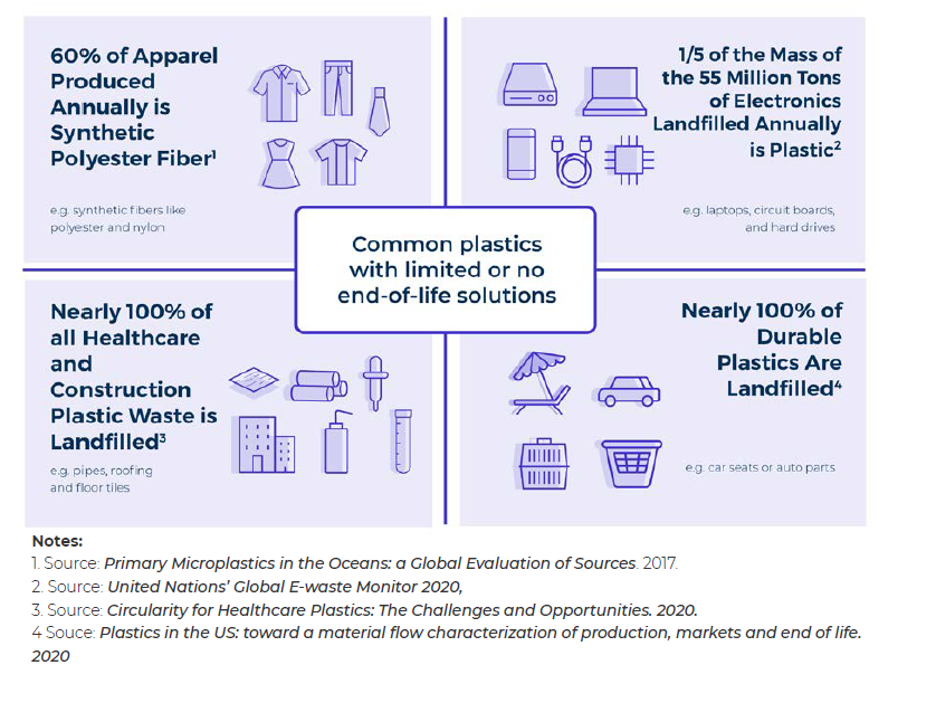
The “plastics waste crisis” has been defined in the public and policy discourse as created by single-use plastics. Yet, two-thirds of plastics put into use in the U.S. today are used for purposes other than single-use packaging. These types of plastics are equally visible and challenging to recover and reuse.
- Molecular recycling can expand the scope of plastic waste we can recycle, helping to preserve the value of resources in our economy.
Figure 4: Inputs and outputs for mechanical, purification, depolymerization and conversion technologies from input to output.

Plastic is as ubiquitous as it is diverse. Our current mechanical recycling system is designed to address only a small fraction of plastics in the market – namely, plastic water bottles (PET), milk jugs (HDPE), and in some markets, yogurt cups (rigid polypropylene). Plastic packaging, like plastic film (LDPE) and clear boxy packaging that many salad mixes are sold in (PET thermoforms) are sometimes downcycled into plastic lumber. Textiles and durable plastics are recycled in lower quantities or not at all because there is less consistent demand for these recycled plastics. As a consequence, most plastic waste ends up in landfill.
Molecular recycling technologies can widen the aperture of plastic waste that we can recycle today beyond packaging. Purification technologies can process electronic waste and films. Depolymerization technologies, which largely focus on PET and polyesters, are a critical recycling solution for synthetic textiles including carpets and athletic clothing. Conversion technologies like gasification can even take mixed waste, breaking down feedstock to basic carbon and hydrogen atoms.
- Conversion technologies like pyrolysis and gasification can process the highest volume of plastic packaging and can accept mixed plastic packaging feedstock.
Closed Loop Partners evaluated nine different technology processes across the three technology categories. When evaluating the total packaging volumes across the United States and Canada, we found that the conversion technologies could accept 82% of all plastic packaging produced, which is more than mechanical, purification, or depolymerization technologies could address alone. These types of technologies also can process mixed plastic waste, while purification and depolymerization requires a sorted and single-resin feedstock. Because feedstock can be mixed, conversion technology companies are often paid to take feedstock rather than paying for feedstock.
Figure 5. Percent of US and Canadian Plastic Packaging that Closed Loop Partner’s Cohort of Molecular recycling Technologies could Address
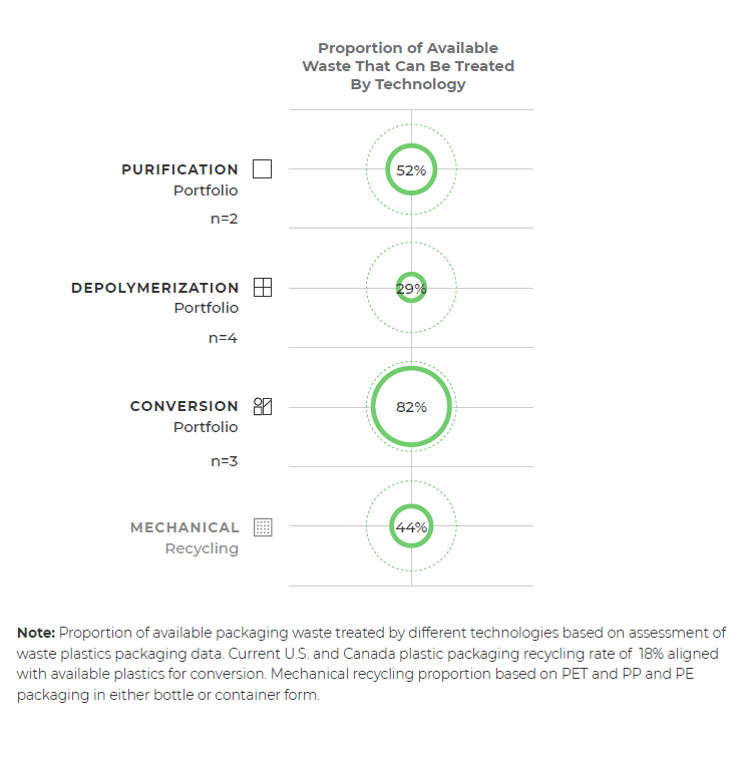
- When considering downstream solutions, a critical metric of success is the amount of recycled plastic (PCR) that each technology solution can produce. The less a polymer is broken down through molecular recycling process, the more recycled plastic will be produced.
Each molecular recycling technology category has a distinct supply chain. For example, purification technologies produce finished recycled plastic. Depolymerization technologies produce monomers which would be sent downstream to be easily repolymerized back into plastic. Conversion technologies have the longest route back to becoming plastic. A pyrolysis technology company will produce pyrolysis oil which would be sent and processed by a steam cracker to produce monomers, which are then sent downstream to make plastic again.
Closed Loop Partners calculated how much plastic resin would be produced by each of the three main molecular recycling technologies discussed in this series (e.g., purification, depolymerization and conversion) if we were to put 1,000 kilograms of plastic feedstock into the technology reactor. Purification yielded the highest amount at 88% of material processing efficiency. Conversion technologies yielded the lowest amount of recycled plastic with a 42% processing efficiency. The capacity to move away from virgin plastics requires the recycling sector to be as efficient as possible.
Figure 6: Average mass yield when 1,000kg of plastic waste is put into each technology process
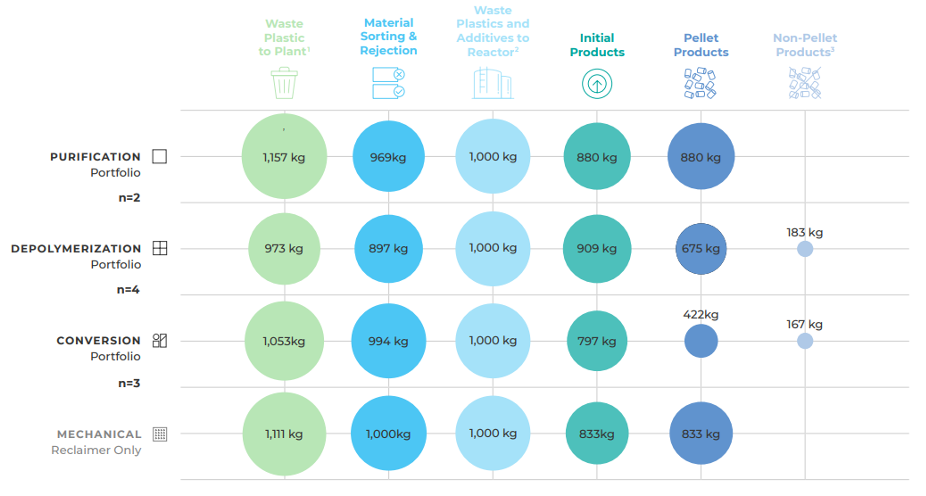
- From an environmental perspective, purification and depolymerization technologies have a smaller environmental footprint, on average, compared to conversion technologies.
Closed Loop Partners also analyzed the energy, greenhouse gases and water impacts of individual technology processes, and the systems-level impact of producing different polymers via purification, depolymerization and conversion technologies. On average, purification was the best performing category across all environmental measures, yielding 20% reduction in greenhouse gas emissions compared to the virgin plastics supply chain. Depolymerization had an average greenhouse gas reduction of 12%, while conversion technologies reduced carbon emissions by 7%, on average. Decarbonizing the plastics supply chain requires prioritizing the solutions that help to meaningfully improve the status quo.
Figure 7: Summary of environmental impacts to produce recycled plastic by technology category
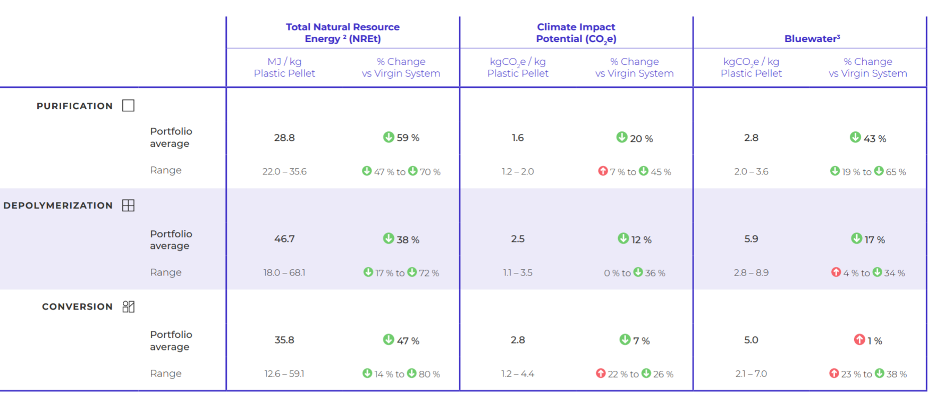
- The less a polymer is broken down through molecular recycling process, the fewer virgin petrochemical inputs are needed to make plastic again – which can reduce the human health impacts of plastic production compared to virgin plastic production.
Several chemical inputs are used to produce plastic. We’ve pictured the chemical tree to make PET which is the plastic used in water bottles. Because plastic can be recycled by many types of molecular recycle technologies, our team wanted to understand the potential human health impacts of different technologies. While qualitative in nature, our findings strongly suggest that the less a polymer is broken down through a molecular recycling process, the lower the human health risk because fewer chemicals and processing are
required to build back the polymer. In the illustration below, depolymerization technologies have an advantage over conversion technologies that can also process PET because depolymerization displaces more of the virgin supply chain to create an equivalent amount of plastic.
Figure 8: Summary of environmental impacts to produce recycled plastic by technology category
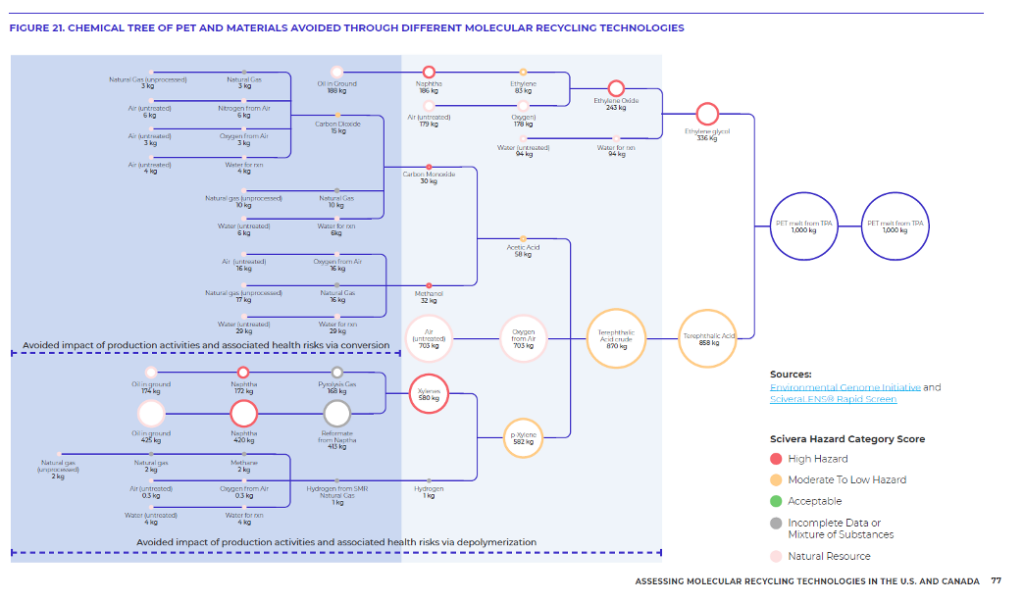
- The economic viability of molecular recycling technologies varies depending on several factors, such as the cost and accessibility of feedstocks and the market demand for the recycled products.
Analyses conducted by Closed Loop Partners over the course of 18 months across nine technology companies found that at least one technology company was financially viable in each category. Specifically, seven of the nine technology companies evaluated had a positive internal rate of return (IRR) ranging from 6% to 62% in the 2021 base case. It is also noteworthy that two-thirds of the technology companies in our study had positive IRRs, given that our base case assumes that these technologies are expected to sell their outputs at market commodity prices without a premium. Figure 5 above summarizes the expected rate of return across three scenarios: 2021 market pricing, 2019 market pricing, and the expected output pricing cited by the technology companies themselves.
Figure 5: Expected Internal Rate of Return (%) Ranges for Each of the Three Molecular Recycling Technologies
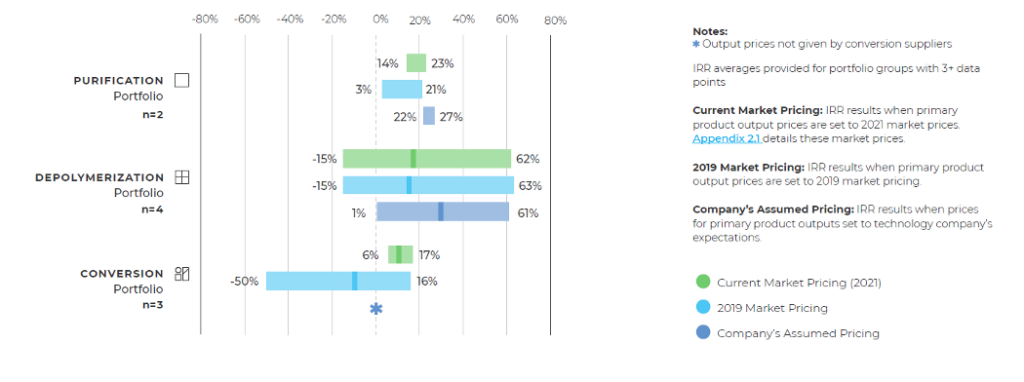
- There are tradeoffs to each molecular recycling technology category and type. The viability of one solution depends on those metrics that matter most to a brand, investor, or community.
The molecular recycling sector is incredibly nuanced and diverse. Not all technology groups are at the same level of development. Their tolerance for mixed plastics or other contamination varies company to company, just like their performance across environmental impact metrics like energy, water and greenhouse gas emissions. Due diligence prior to investing in strong performing technologies is critical. Closed Loop Partners has summarized the results when observing the category averages between purification, depolymerization, and conversion in the table below. This summary is based on our review of nine technology companies between 2020-2021 and should only serve as a point of data, not a definitive source on the state of the sector at large. The opportunity for consumer brands, policymakers, and investors is to collaborate to develop a vision of success for this sector.
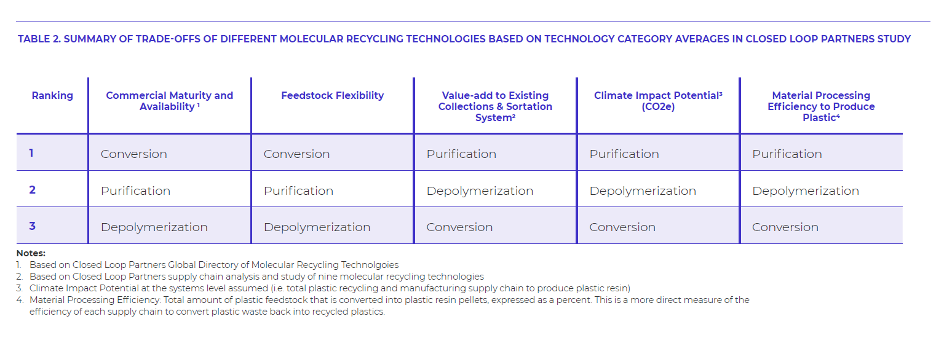
To read our full report on molecular recycling technologies, including a list of more than 100 questions that investors and brands should ask when considering investing in this sector, visit Closed Loop Partner’s website.
The Most Sustainable Bag Is Likely the One You Already Own: 5 Things YOU Can Do to Reduce the Need for Single-Use Plastic Bags
July 19, 2023
How often do you get to the checkout counter only to realize you’ve left your reusable bags at home or in the car? It’s happened to all of us, including me.
Don’t be that person stashing plastic bags until your drawer begins to overflow. In addition to going bagless for quick shopping trips, here are 5 tips for remembering to bring your own bag, so YOU can reduce the need for single-use-plastic bags:
- Make it visible. Write “bring bags” at the top of your grocery list and leave bags in a basket near your front door or hanging on the doorknob, so you don’t forget them as you are leaving the house.
- Make it available. Always keep a few bags in your car for spontaneous shopping trips.
- Make it essential. Place an important item in the bag, like your phone, keys or wallet, so you won’t forget it.
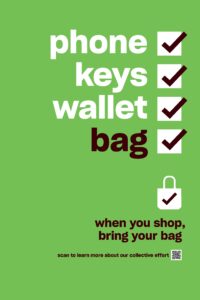
4. Make it personal. Purchase reusable bags you actually like, so you’ll be more inclined to carry them with you.
Why is this so important? Every year, 100 billion single-use plastic bags are used annually in the U.S., and its estimated fewer than 10% of them are recycled.

While the convenience of the single-use plastic retail bag can’t be disputed, the negative impact — considering its short use (12 minutes, on average) and long estimated lifespan — has created an untenable situation that is contributing to a mounting global waste crisis. Plastics can now be found in the deepest depth of the ocean, the top of Mount Everest, and on both polar ice caps.
Reducing the number of single-use plastic bags retailers use across their stores can make a tremendous difference. Even a 1% bag reduction would have a substantial impact on our global waste footprint – equivalent to 1 billion fewer bags used and discarded across the U.S.
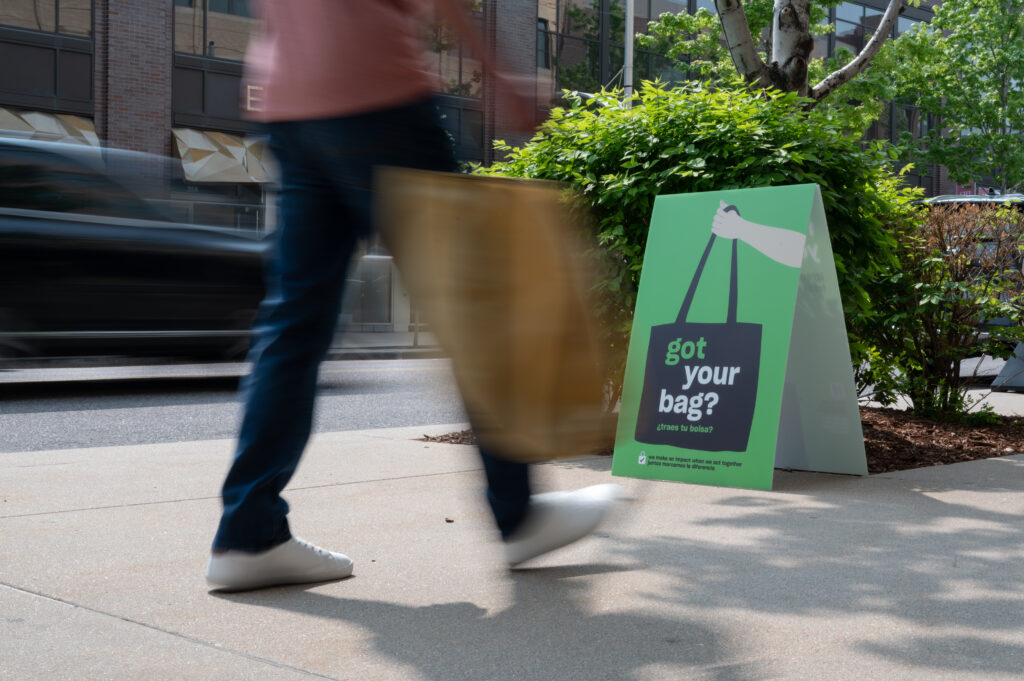
If you’re already regularly using reusable bags, you are not alone! Learn more about our pilots in Denver and Tucson where 150+ retailers are working together to help all of us reinforce the habit of bringing our bags. Additionally, check out our new playbook full of solutions retailers can implement today to get teams and customers on board with reducing single-use plastic bags and encourage shoppers to reuse their own bags.
While there’s a lot retailers can do; remember, we’re all in this together and YOU can make a difference by reducing the need for single-use plastic bags.
Reuse
How Today’s Single-Use Habits Can Inform the Direction of Reuse Systems of the Future
April 24, 2023
To build successful reuse systems, we need to make reuse a natural choice for customers.
With around 250 billion single-use cups used globally each year, contributing to greenhouse gas emissions and lost resources, there is a significant opportunity to reduce our waste by learning from the journey of everyday materials, like cups, that are part of many people’s daily routine. Understanding customer motivation, preference, and behavior is a critical step in advancing a circular economy, where materials are kept in circulation and designed with their next life and use in mind.
Over the past two years, our NextGen Consortium has surveyed thousands of customers on how they buy and consume beverages on the go, and what they do with their cups after they are done. We examined survey results* across three types of cups for: 1) hot coffee, 2) iced coffee, and 3) fountain soda. These findings inform not only how to improve recycling and composting outcomes for cups today, but also how to optimize for reusable cup systems in the future.
What we learned:
1) Lives are busy, and people sip on the go.
- Most customers purchase drinks in single-use cups during busy, on-the-go moments, and drink them in their car
- Most people finish drinking within 30 mins to one hour, but hold on to their cup for an hour or more––except for hot coffee drinkers, who generally dispose of their cups in less than one hour
2) Nearly half of all cups finish their journey at home.
- The most common cup journey starts in a drive-thru, is consumed in a vehicle, and then is placed in the trash at home
- Few customers dispose of their cup at a coffee shop/restaurant, including in the parking lot
- Most cups end up in waste streams at home, work or school
3) Reusing a cup is more common than it may appear.
- This is especially true for convenience/gas station purchases and among customers with lower income
- Customers are significantly more likely to bring their reusable coffee cups to convenience/gas station vs. other restaurant/coffee shop settings
4) Once customers embrace reuse, they tend to stick to it.
- Of customers who typically reuse their cup, half say they “almost always” bring a refillable cup with them
5) There is a desire to cut down on waste if it is convenient.
- Customers express an interest in different disposal methods, but don’t want to go out of their way to do so
- While the majority of customers prefer to reuse or recycle their cups, the say-do gap is real, and the process to recycle or reuse needs to be seamless for people
- Given the choice, customers say they would rather recycle their cup than throw it in the trash
Gaining a better understanding of how customers use and dispose of single-use cups today helps to inform the optimal design of reusable cups and cup sharing systems. As we test these new systems and think through what it will take for reusable cups to become part of our cultural norms and daily habits, these survey findings can help us meet customers where they are instead of expecting new behaviors. These findings also prompt important questions, such as:
- How can we make it easy for customers to borrow reusable cups in drive thrus and return the cups on the go and/or from their homes or place of work?
- How do we continue to strengthen multi-brand partnerships to build dense networks of restaurants and coffee shops participating in collaborative returnable cup programs?
- If customers are still not clear on where to dispose their single-use cups, how do we educate them when a fourth bin of reusable cups is added to the equation? And how do we design reusable cups for recoverability when they do end up in a recycling bin?
- For beverages consumed in the car, how might we encourage the use of more durable and insulated reusable options that replicate the performance benefits of styrofoam, a much less sustainable option?
- Since the overwhelming number of cups are disposed of at home, the office or at school, can we explore residential or commercial reusable cup collection services that make participation as easy as disposing a cup in the trash or recycle bin?
Bottom line: To build successful reuse systems, we need to make reuse a natural choice for customers. If we make it easy for customers, as part of their busy daily routine, we can make reuse the top option for millions of people.
Our customer research findings are critical inputs to the NextGen Consortium’s broader strategy to accelerate the transition to reuse. We’ve been researching and testing reusable cups since 2018 and will continue to iterate and advance in 2023 and beyond with in-market tests and other studies, such as financial modeling and environmental impact analyses on reuse. If you would like to be a part of our upcoming studies and pilots, get in touch with us at [email protected].
* To explore customer behavior related to single-use cups, the NextGen Consortium conducted three, quantitative surveys with 2,500 U.S. respondents each focused on 1) hot coffee cups, 2) iced coffee cups, and 3) fountain soda cups over a period ranging from two to three weeks in 2021 and 2022. We examined how customers buy and consume beverages in single-use cups as well as what happens to the cup after purchase. In these studies, “customer” refers to respondents who purchase hot coffee, iced coffee, or fountain soda out of the home regularly, at least once per week.
Reuse
How Personalized Home Delivery Models Could Spur Successful Reuse Systems
March 23, 2023
Georgia Sherwin, Senior Director at Closed Loop Partners’ Center for the Circular Economy interviews Bruno Ballester, ROYAL CANIN Individualization Senior Product Owner. ROYAL CANIN® offers customized pet food and home delivery in reusable packaging to meet the diverse needs of pet owners and in the process has generated interesting learnings about reuse adoption.
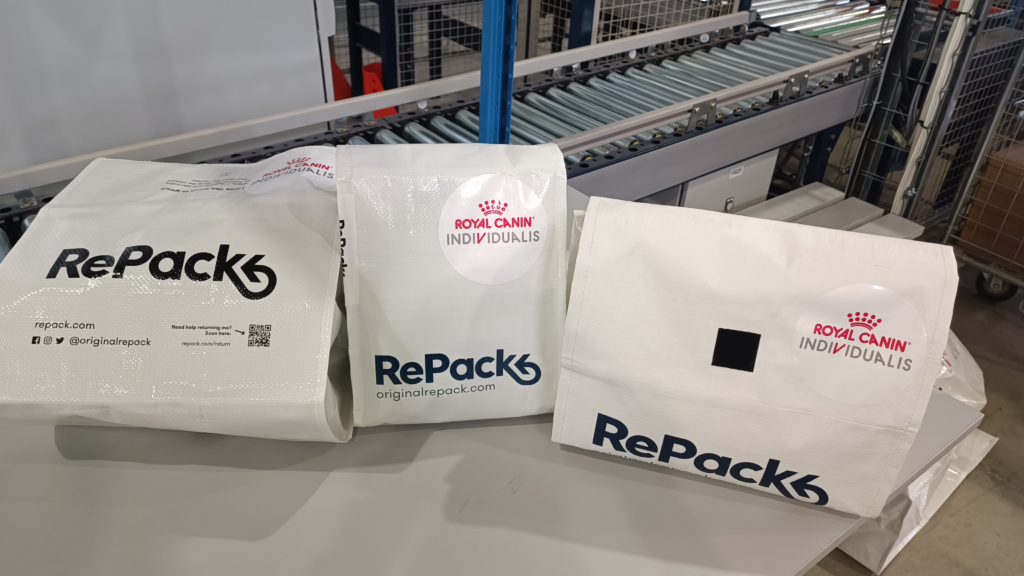
- In a nutshell, can you describe the reusable packaging system implemented by ROYAL CANIN and how it works?
Since June 2022, ROYAL CANIN®, a brand of Mars, Inc, has been partnering with reusable packaging innovator RePack to offer a sustainable solution for home deliveries of ROYAL CANIN IndividualisTM pet food refill orders in France, representing thousands of orders per month. ROYAL CANIN® IndividualisTM is an on-demand, individualized nutritional program created to answer every pet’s unique health needs. Pet owners receive their ROYAL CANIN order in returnable RePack delivery packaging. Once empty, the RePack packaging can be returned through the postal system for free, after which it is cleaned and reused. The packaging can go through this process up to 20 times. The reuse delivery packaging guarantees intact quality of our products at delivery.
After 20 cycles, analysis shows that RePack packaging results in only 0.1kg of waste and 0.9kg of CO2 emitted, compared to 3kg of waste and 4.4kg of CO2 for a cardboard box. The process represents a reduction of 80% of CO2 when comparing the lifecycle of a RePack bag to disposable packaging. We are now exploring potential opportunities to expand this project to the rest of Europe and North America.
- Why did you decide to implement a reuse model for ROYAL CANIN®? What factors contributed to it?
ROYAL CANIN® is committed to furthering sustainability across all our operations, knowing that reuse, recycling and upcycling packaging are key contributions in alleviating the impact of our activity and helping create a healthy future for pets, people and the planet. We also signed the Ellen MacArthur Foundation’s New Plastics Economy Global Commitment, which encourages responsible behavior and calls for collective engagement to ensure a common vision of a circular economy for plastic, in which it never becomes waste or pollution.
We feel that reuse habits have been lost to today’s dominant single-use, disposable culture, but we think reuse is a trend that is coming back and could become the norm.
This opt-out model for reuse has helped ensure momentum.
- How has customer adoption evolved over time since the launch of the program?
Customer adoption of the reusable RePack packaging program has been a great success. Importantly, while we leave the choice to our customers to ask if they prefer to switch back to the previous packaging approach, after several thousand orders, no customer has asked to change. This opt-out model for reuse has helped ensure momentum. We also inserted a QR code to collect feedback after each order and the overwhelming feedback from customers was positive. The program received a Net Promoter Score of 76, which indicates that the majority of customers are satisfied and would recommend the approach. In fact, a lot of customers noted they were surprised this type of solution isn’t being deployed more widely and becoming the norm.
A couple of great customer quotes about the reusable packaging system worth highlighting include, “I think it’s an excellent idea, congratulations to the inventor”, “I love it”, “a perfect solution”, “it is a very good initiative. I hope that many companies will follow this”, and “I find this idea great and very practical.” This kind of feedback is really encouraging for us to continue to push the bounds of sustainability initiatives. Beyond our net promoter score increasing, which indicates positive customer satisfaction, we’ve also saved time from an operations perspective by packing parcels with RePack vs. cardboard boxes.
- What’s been the biggest challenge for the program?
There are many different considerations when it comes to reuse. We usually ship our premium pet food in protective cardboard boxes to preserve the quality and the health benefits of the finished product up to the point of final consumption. Therefore, we had to ensure RePack packaging was strong enough to guarantee intact quality at delivery. It was also important for us to monitor and measure the feasibility of the program: how can we offer reusable packaging for each customer each month without increasing the costs? Should this solution cover several countries, or should we select one single country? And we kept a constant eye on customer satisfaction––are customers willing to return the packaging each month?
- What did it take to get the program off the ground? What key stakeholders and resources were involved?
ROYAL CANIN® ran a test over two months with 15 pet owners and sent them their refill order in a RePack packaging. They agreed to share their experience during individual interviews. This first test was very successful and received, on average, a rating of 4.8/5. Customers reported that RePack was: 1) Easy to use 2) Sustainable 3) A good solution for e-commerce. This valuable feedback helped us scale the reusable packaging project, whilst also recognizing what information was most relevant to French customers.
We also organized a workshop in our warehouse in France where all ROYAL CANIN® Individualis™ orders are prepared, packed and shipped. We met with the RePack team to review the order preparation as we were kicking off the first orders for the small pilot.
The product packaging size can vary significantly depending on if it is for a cat or a large dog for example, and therefore we usually need three sizes of cardboard boxes. The three sizes of RePack allowed us to meet our packaging needs perfectly. We tried RePack’s different sealing methods to find the most efficient and secure one for us. We tested the solidity of the packaging with a test and validated an International Safe Transit Association (ISTA) certification certifying that RePack packaging protected the pet food during transport.
Closed Loop Partners Releases Playbook of Tangible Single-Use Plastic Bag Reduction Solutions for Retailers
March 14, 2023
Playbook highlights tried and tested solutions from partners in the Consortium to Reinvent the Retail Bag that can drive near-term, positive environmental impact and cost savings
NEW YORK, March 14, 2023 — Closed Loop Partners’ Center for the Circular Economy and its Consortium to Reinvent the Retail Bag released a new playbook to provide near-term single-use bag reduction wins that can be implemented by any retailer–– from small local stores to large national brands. The resource highlights effective solutions to reduce the number of bags needed by retailers and encourage the use of reusable bags customers already have at home. Key insights from the playbook are based on research, interviews, surveys and learnings from 17 of the world’s leading retailers across four key categories: communications, employee training, bag and fixture design, and customer incentives.
The playbook highlights 25 strategies across these four categories that cater to retailers who are at different stages of their journey. These strategies include detailed guidance on how best to prompt customers to bring their own bags, where to place reusable bags, items retailers can skip bagging, which customer incentives can be deployed and other strategies. The playbook insights are the product of a first-of-its-kind collaboration among Closed Loop Partners and many of the world’s leading retailers, including 14 retail partners in the Consortium to Reinvent the Retail Bag and three external retailers. Experts from Closed Loop Partners led the creation of the playbook, supported by retail consultancy, McMillanDoolittle, who performed quantitative and qualitative surveys and deep-dive interviews with retailers, supplemented with secondary research and analysis.
Reducing the number of single-use bags that retailers use across their stores can make a tremendous difference. Even a 1% bag reduction has a significant impact on our global waste footprint––in the U.S., that is equivalent to 1 billion fewer bags used and discarded. Beyond driving progress toward sustainability goals, using fewer single-use bags can also help retailers reduce costs, address challenges in stocking bags, engage employees, support customers, and build brand reputation and loyalty.
“Our new playbook walks retailers through strategies they can implement today to get teams and customers on board with reducing single-use bags in stores and encourage shoppers to reuse their own bags,” said Kate Daly, Managing Director of the Center for the Circular Economy at Closed Loop Partners. “This tool is for retailers who are looking for quick wins and those seeking innovative, new approaches. We hope these insights serve as an inspiration to retailers looking to reduce their plastic footprint and deploy bag reduction solutions.”
The Consortium to Reinvent the Retail Bag has been working to reimagine the retail bag in the store and across emerging channels like local delivery since its launch in 2020. The last three years have shown significant progress––growing from five retail partners to 15, and deploying more than 6,000 iterative tests, surveys and pilots across markets to help accelerate learnings and the development of sustainable bag solutions. This year, the Consortium will go back into market on a larger scale, testing different complementary strategies to reduce single-use bags. This work will build on the Consortium’s different workstreams––innovation, customer research, policy and infrastructure––and efforts to date. There is no silver bullet to addressing a global plastics waste challenge, and the diverse in-market efforts represent the multi-pronged holistic approach of the Consortium.
In Spring 2023, Consortium partners will test multiple strategies from the Playbook simultaneously in two cities in Arizona and Colorado, launching signage, marketing and customer prompts across stores. The goal of these tests is to enable a broader cultural shift towards customers bringing their own reusable bags from home. The Consortium is inviting other retailers––from mom-and-pop shops to large brands––to join and test the same prompts, signage and marketing materials in order to have the broadest reach with customers and to create ecosystem-wide impact.
Meanwhile, in New Jersey, where there is legislation banning single-use bags in certain stores, the Consortium will test a “returnable bag service” model in which customers are “borrowing” a bag onsite, reusing it before eventually returning it at the same or different retailer’s store to be washed, redistributed and reused by additional customers. This offers a solution for when customers forget to bring their own reusable bags.
Interested retailers can email [email protected] to inquire about joining the Consortium to Reinvent the Retail Bag to gain access to useful research, insights and continued in-market experimentation as well as potentially participate in pilots in Arizona and Colorado.
Learn more at http://beyondthebaginitiative.com/
About the Center for the Circular Economy at Closed Loop Partners
The Center for the Circular Economy at Closed Loop Partners unites competitors to tackle complex material challenges and to implement systemic change that advances the circular economy. Adept at navigating every step in the value chain, Closed Loop Partners brings together designers, manufacturers, recovery systems operators, trade organizations, municipalities, policymakers and NGOs to create scalable innovations that target big system problems. The Center’s first initiative, the NextGen Consortium, assembled leading food and beverage companies, including McDonald’s and Starbucks, to identify and commercialize a widely recyclable, compostable and/or reusable cup. 12 winning cup solutions were selected and the Consortium is supporting the testing of these new solutions as well as conducting select pilots to accelerate their path to scale. Learn more about the Center’s work here.
About the Consortium to Reinvent the Retail Bag
The Beyond the Bag Initiative, launched by the Consortium to Reinvent the Retail Bag, aims to identify, pilot and implement viable design solutions and models that more sustainably serve the purpose of the current retail bag. Closed Loop Partners’ Center for the Circular Economy launched the initiative with Founding Partners CVS Health, Target and Walmart. The Kroger Co. joined as Grocery Sector Lead Partner, DICK’S Sporting Goods joined as Sports & Outdoors Sector Lead Partner, Dollar General as Value Sector Lead Partner, TJX as Apparel & Home Goods Sector Lead Partner, and Ulta Beauty as Beauty Sector Lead Partner. Ahold Delhaize USA Brands, Albertsons Companies, H-E-B, Hy-Vee, Meijer, Wakefern Food Corp., and Walgreens are Supporting Partners, and Conservation International and Ocean Conservancy serve as Environmental Advisory Partners. Learn more about the Consortium here.
Contact: [email protected]
